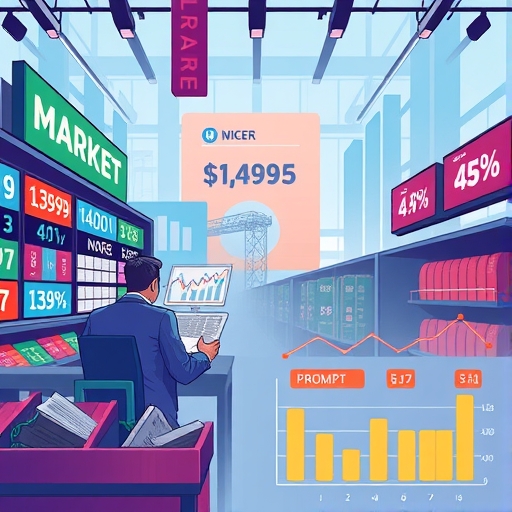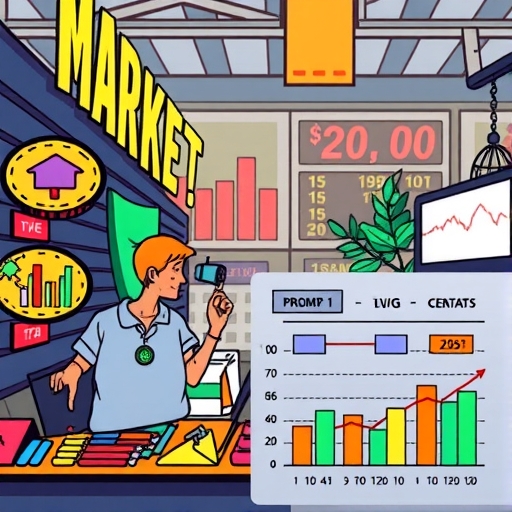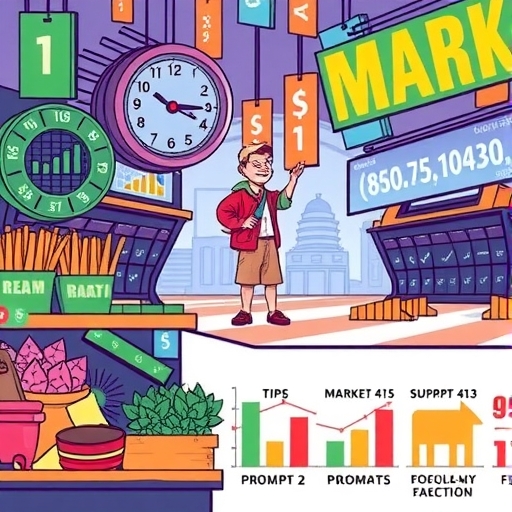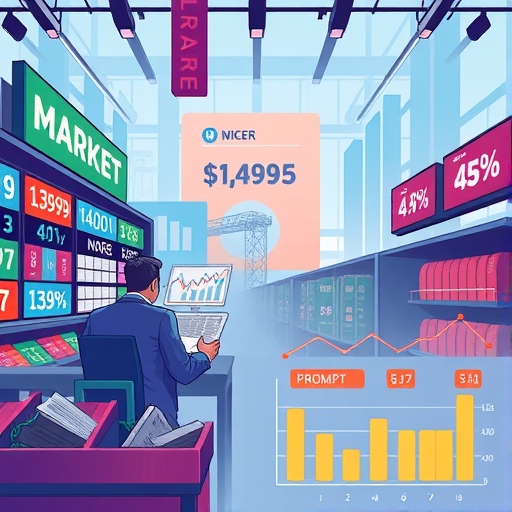Hello, fellow traders and economic enthusiasts! Welcome to a deep dive into a topic that impacts every single one of us, whether we’re analyzing charts, planning investments, or simply buying groceries: **price variation**. Prices aren’t static; they are constantly shifting, influenced by a complex interplay of forces. Understanding *why* prices move is just as crucial as identifying *where* they might move on a chart. It provides the fundamental context that technical analysis builds upon.
- Price variation is influenced by economic indicators such as the Consumer Price Index (CPI).
- Factors driving price changes include supply chain disruptions, government policies, and overall consumer demand.
- Technical analysis can be enhanced by understanding the economic context behind price movements.
In today’s economic landscape, navigating these price changes feels particularly challenging. We hear about inflation, supply chain issues, and trade policies, but what do they truly mean for the prices you see and the markets you trade? Together, let’s break down the key drivers behind recent price variations in the U.S. economy, using the latest available data as our compass.

Our journey begins with the benchmark indicator for consumer prices: the **Consumer Price Index (CPI)**. Think of the CPI as a giant shopping basket filled with goods and services that average households buy. The Bureau of Labor Statistics (BLS) tracks the prices of these items over time to measure inflation – the rate at which prices increase. For traders and investors, CPI data releases are critical events, often causing significant market volatility because they influence expectations about the Federal Reserve’s monetary policy decisions.
The most recent data for May 2025 showed that the **CPI for All Urban Consumers (CPI-U)** increased by a modest **0.1%** on a seasonally adjusted basis from the previous month. Looking at the bigger picture, the index was up **2.4%** over the past 12 months before seasonal adjustment. This suggests that while inflation hasn’t disappeared, its monthly pace might be moderating compared to peaks seen earlier.
| Indicator | May 2025 Value |
|---|---|
| CPI-U Monthly Change | +0.1% |
| CPI-U Yearly Change | +2.4% |
But why do analysts often focus on the “core” inflation rate? The BLS also reports the index for **”All items less food and energy.”** This core CPI is considered a better gauge of underlying inflationary pressures because it excludes the volatile food and energy categories, which can swing wildly based on short-term supply disruptions, weather events, or geopolitical factors. In May, the core CPI also rose by **0.1%** monthly, but its year-over-year increase was higher than the headline figure, coming in at **2.8%**.
What does this difference between headline (2.4%) and core (2.8%) tell us? It signals that while energy prices have eased (more on that later), other components, particularly services and non-energy goods, are still experiencing price pressures. For a trader, understanding this distinction is key. It highlights that inflation isn’t a single, monolithic force; it has different speeds and drivers across the economy.
| Core vs Headline CPI | May 2025 Value |
|---|---|
| Headline CPI | 2.4% |
| Core CPI | 2.8% |
Delving deeper into the CPI components, one stands out as a primary contributor to the ongoing price increases: **shelter**. In May, shelter costs rose by **0.3%** for the month. This category, which includes rent for primary residences, owners’ equivalent rent (OER), and lodging away from home, carries a significant weight in the overall CPI calculation. Its persistent rise has been a major factor keeping the overall inflation rate from falling faster.
Why are shelter costs so sticky? Rent agreements are typically long-term, and price changes often take time to filter into the official data. Owners’ equivalent rent, which estimates how much a homeowner would pay to rent their own home, is based on surveys that can also lag behind real-time housing market shifts. This lag means that even if market rents or home prices start to cool, it takes several months for that deceleration to show up meaningfully in the CPI shelter component.
For investors, particularly those focused on real estate-related stocks or inflation-protected securities, understanding the dynamics of shelter costs is vital. Its stickiness influences the Federal Reserve’s perspective on inflation and, consequently, their decisions regarding interest rates. A persistent rise in shelter keeps pressure on the Fed to maintain a tighter monetary policy stance, which can impact everything from bond yields to the cost of corporate borrowing.

Beyond the broad strokes of monetary policy and consumer demand, specific government policies can have a direct and often immediate impact on prices. Tariffs are a prime example. These taxes on imported goods are designed to make foreign products more expensive relative to domestic ones, but they often result in higher costs passed directly onto consumers and businesses.
The provided data offers tangible examples of how tariffs are translating into price increases. We see reports of products undergoing **”re-ticketing,”** where retail prices are simply adjusted upwards due to the added cost of tariffs. This isn’t just a theoretical impact; it’s showing up as 8% to 15% price hikes on various consumer products and apparel.
Looking ahead, the impact of tariffs continues to build. Footwear, for instance, is expected to see price increases of 6% to 10% in 2025, largely attributed to ongoing tariff effects. This isn’t a one-time shock; it’s a persistent upward pressure on the price of goods that originate from, or transit through, countries targeted by these duties, such as China.
| Product Category | Expected Price Increase |
|---|---|
| Footwear | 6% to 10% |
How does this affect businesses? The uncertainty surrounding trade policy and the direct cost of tariffs are leading companies to make strategic shifts. Some are absorbing costs where they can, but many must raise prices. Others are diversifying their sourcing locations away from heavily tariffed regions like China towards places like Southeast Asia, India, or Vietnam. This diversification adds complexity and potentially costs to supply chains, which can also feed into higher end-prices.
For traders, tariffs introduce a layer of political risk and sector-specific impact. Companies with heavy reliance on imports from tariffed regions might face margin pressure or declining sales volume if they raise prices too much. Conversely, domestic producers or companies that have successfully diversified sourcing might be relatively better positioned. Analyzing a company’s exposure to trade policy is a crucial part of fundamental analysis in this environment.
The pandemic brought the concept of supply chains into mainstream discussion, highlighting how disruptions can lead to scarcity and, consequently, higher prices. While some of the acute bottlenecks of recent years have eased, the supply chain remains a critical factor influencing price variation, often in subtle but significant ways.
A key indicator to watch is **inventory levels**. The provided data shows that overall inventory levels are currently quite lean, perhaps around a 3-month supply compared to a historical norm closer to 6 months. Why are businesses holding less inventory? Tariff uncertainty makes importing large volumes riskier, and lessons learned during the pandemic about overstocking slow-moving items are fresh. Additionally, predictions of potentially softer consumer demand encourage a more cautious approach.

This shift towards leaner inventories has several implications. While lower inventory reduces storage costs, it also makes the supply chain less resilient to unexpected demand spikes or disruptions. It suggests a potential **milder peak season** for imports and logistics compared to previous years. Logistics managers’ indices (LMI) and data from ports like Los Angeles, Long Beach, and New York/New Jersey show trends supporting this – potentially lower container volumes and shifts in port activity.
Furthermore, companies are reportedly reducing the number of **SKUs (Stock Keeping Units)** they carry. This means less product variety on shelves or in warehouses. While this simplifies logistics, it could potentially limit consumer choice and, in some cases, make certain specific items harder to find, potentially leading to localized price increases due to reduced availability.
For traders interested in logistics, transportation, or retail sectors, monitoring inventory data, port traffic reports, and LMI surveys provides valuable insights into the health and efficiency of the supply chain – factors that directly influence operational costs and the ability to meet consumer demand without price hikes.
Transporting goods across oceans is a fundamental part of global supply chains, and the cost of this transport – **ocean freight rates** – is a significant input cost that can influence the final price of imported goods. Observing trends in freight rates gives us clues about the balance of supply and demand in global shipping and the confidence level of importers.
Recent data on ocean freight spot rates on key routes, such as the **Trans-Pacific West Coast**, shows significant drops. This is a notable signal. High freight rates typically indicate strong demand for shipping capacity (lots of goods being imported) and/or limited capacity (port congestion, container shortages). Falling rates, conversely, often suggest weakening import demand and/or increasing vessel availability.
What could be driving these lower rates? The anticipation of a milder peak season (less goods being shipped) is one factor. Importer hesitation, partly fueled by the tariff uncertainty we discussed, likely plays a role too. If businesses are less certain about demand or worried about the final cost due to tariffs, they might hold back on placing large import orders, reducing demand for shipping.
While ocean freight rates are only one piece of the cost puzzle, a sustained decline can eventually translate into lower costs for importers and potentially ease some price pressures on consumer goods. Conversely, a sudden spike could signal renewed supply chain stress or a surge in demand. Keeping an eye on these indicators, often reported by maritime analysis firms, provides a forward-looking perspective on potential future price movements for imported products.
While headline inflation gives us an average picture, the reality of price variation is that it hits different sectors and products very differently. Nowhere is this more evident than in the **food** category, where prices are influenced by unique factors like weather, disease outbreaks, and global commodity markets, in addition to the broader economic forces.
Overall food prices in the U.S. were up **2.9%** year-over-year through May 2025, according to BLS data. However, this average masks significant variation within the category. We see a distinction between **food-at-home** prices (groceries) and **food-away-from-home** prices (restaurant meals, fast food). Food-away-from-home has been rising faster, up **3.8%** year-over-year, compared to food-at-home at **2.2%**.
| Food Categories | Year-over-Year Change |
|---|---|
| Food-at-home | +2.2% |
| Food-away-from-home | +3.8% |
Within groceries, some specific items have experienced dramatic price swings. **Eggs**, for example, were still remarkably high, up **41.5%** year-over-year in May, despite some recent monthly declines. This extreme volatility is a direct consequence of factors like Highly Pathogenic Avian Influenza (HPAI) outbreaks, which severely impact egg-laying hen populations and thus reduce supply. When supply shrinks dramatically relative to demand, prices can soar, illustrating the power of specific, non-economic shocks on certain categories.
Other categories also show significant increases. **Beef and veal** prices were up **8.6%** year-over-year, likely driven by a combination of strong consumer demand and supply constraints within the cattle industry. The U.S. Department of Agriculture (USDA) Economic Research Service (ERS) closely monitors these trends and provides forecasts. Their projections suggest average U.S. food prices will increase by **2.9%** in 2025, aligning with the current trend, with food-away-from-home expected to continue outpacing food-at-home inflation.
For traders focused on agricultural commodities, food processing companies, or restaurant chains, understanding these specific sectoral dynamics and their underlying causes (like HPAI or cattle cycles) is far more valuable than just looking at the overall food index. These factors can directly impact the profitability and stock prices of companies in these industries.
While food and shelter are major drivers, other categories within the CPI also contribute to the overall price variation story. The **energy index**, which includes gasoline, fuel oil, electricity, and piped gas, saw a monthly decline of **1.0%** in May and was down **3.5%** year-over-year. This decrease was primarily driven by significant drops in gasoline and fuel oil prices compared to the previous year.
However, even within energy, there’s variation. While gasoline prices eased, the cost of **energy services** like electricity and utility (piped) gas service can move differently, influenced by local supply/demand, infrastructure costs, and weather patterns. Traders following energy markets know that global supply (OPEC decisions, geopolitical events) and demand (economic activity, seasonal changes) are constant influences on these prices, creating significant trading opportunities but also volatility.
Looking at other CPI components, we see further divergence:
- **Transportation Services:** Saw a monthly decrease in May, partly due to declining airline fares. However, other components like motor vehicle insurance continue to rise significantly over the year.
- **Medical Care Services:** Continued to see price increases.
- **Apparel:** Experienced a monthly decline in May, suggesting some price relief in clothing.
- **Used Cars and Trucks:** Prices have been volatile, impacting the overall commodities index.
What do these varied movements tell us? They reinforce that inflation isn’t uniform. Some categories are seeing prices decrease, others are stable, and some continue to rise sharply. This highlights the impact of supply/demand imbalances, specific market conditions, and even seasonal factors on individual components of the economy.
So, we’ve explored the data – the CPI numbers, the impact of tariffs, the signals from the supply chain, and the varied movements in specific sectors. But how do you, as a trader or investor, translate this complex picture into actionable strategies? Understanding these economic fundamentals provides a crucial layer of insight that complements and strengthens technical analysis.
Economic data, particularly on inflation, directly influences central bank policy. When the Federal Reserve sees persistent inflation, it is more likely to maintain higher interest rates or delay rate cuts. Higher interest rates affect everything from the cost of borrowing for companies (impacting stock valuations) to bond yields (making fixed income more attractive) and currency values (higher rates can attract foreign capital, strengthening the currency). Watching the market’s reaction to CPI releases and Fed statements is a key part of trading macroeconomics.
Insights into supply chain dynamics can help identify potential winners and losers. If inventory levels are low and a milder peak season is expected, transportation and logistics companies might face reduced demand, potentially impacting their performance. Conversely, companies that have successfully built resilient supply chains or diversified sourcing might be better positioned to manage costs and maintain profitability.
Sector-specific price movements offer opportunities. If you understand *why* egg prices are soaring (HPAI), you might look at investments related to alternative proteins or companies involved in biosecurity for poultry. If beef prices are high due to supply issues, you might analyze cattle futures or companies in the meat processing industry, considering whether the trend is sustainable.
Technical analysis provides the “when” – identifying entry and exit points based on chart patterns, indicators, and price action. Fundamental economic analysis, like understanding price variation drivers, provides the “why” and the “what” – helping you identify which markets or sectors might be poised for a move and what the potential catalyst could be. Combining both approaches often leads to more robust trading decisions.
If you are considering starting forex trading or exploring more CFD products, then Moneta Markets is a platform worth considering. It comes from Australia and offers over 1000 financial instruments, making it suitable for both beginners and professional traders.
In the world of financial analysis and trading, the principles of Expertise, Experience, Authority, and Trustworthiness (EEAT) are paramount. When you’re making decisions based on economic data like price variations, relying on information that adheres to these principles is crucial for success and avoiding costly mistakes.
Our analysis today relies heavily on data from authoritative sources like the **U.S. Bureau of Labor Statistics (BLS)** for CPI data and the **U.S. Department of Agriculture (USDA) Economic Research Service (ERS)** for food price forecasts. These are government agencies with the specific mandate and expertise to collect, analyze, and report this information accurately. Relying on their official reports, rather than unverified claims, is fundamental to trustworthy analysis.
Experience comes from observing how these economic factors have played out in markets over time. Experienced traders know that while data provides a snapshot, the market’s *reaction* to the data can be complex, influenced by expectations, sentiment, and other concurrent events. They’ve seen how tariff wars impact specific industries or how supply shocks in commodities can create unexpected trading opportunities or risks.
Expertise involves not just presenting the data but interpreting it within the broader economic context. This means understanding the methodologies behind indices like the CPI, recognizing the lag in certain components like shelter, and connecting seemingly disparate factors like ocean freight rates and retail inventory levels. It’s about building a holistic picture, not just reciting numbers.
Trustworthiness is built on consistent, accurate analysis, acknowledging uncertainties, and avoiding sensationalism. When discussing price variation, it’s important to present the nuances – acknowledging where inflation is slowing and where it remains persistent, and identifying the specific drivers behind each trend. This balanced perspective allows you to form realistic expectations about market movements.
As knowledge seekers in the financial markets, embracing the principles of EEAT in how we consume and analyze economic information is essential. It’s the foundation for making informed decisions, whether you’re building a long-term investment portfolio or executing short-term trades.
Given the complex and sometimes contradictory signals we’ve discussed – moderating headline inflation versus persistent core pressures, tariff-driven price hikes alongside easing freight costs, and specific sectoral volatility – how can a trader effectively navigate this environment?
- **Stay Informed:** Regularly review official data releases (CPI, PPI, GDP, Retail Sales, etc.) from sources like the BLS and BEA. Understand the data’s components and limitations.
- **Analyze Sector by Sector:** Don’t just trade the overall market. Look for opportunities or risks in specific sectors influenced by the factors discussed. Logistics, retail, agriculture, manufacturing, and even financial stocks (influenced by interest rates) are all impacted differently by price variation and supply chain dynamics.
- **Consider Commodity Exposure:** Commodities like energy and agricultural products are often direct indicators and drivers of price variation. Trading commodity futures, options, or stocks of companies involved in production/processing can be a way to potentially capitalize on or hedge against these price movements.
- **Focus on Currency Markets (Forex):** Inflation data and central bank responses have a significant impact on currency values. Understanding how inflation expectations influence interest rate differentials between countries is fundamental to Forex trading.
- **Combine Fundamentals with Technicals:** Use economic insights to identify *potential* market directions or areas of interest, then use technical analysis to refine entry and exit points. For example, if CPI data suggests the Fed might raise rates, you might look for technical setups to potentially short bond futures or trade currency pairs influenced by USD strength.
- **Manage Risk Prudently:** Economic uncertainty often leads to market volatility. Employ robust risk management techniques, such as setting stop-loss orders and position sizing appropriately, to protect your capital.
This environment isn’t about predicting the future with perfect accuracy, but rather about understanding the forces at play and adapting your strategy accordingly. The “sage” approach in trading is about continuous learning and analytical rigor.
Predicting the future path of price variation is challenging because it depends on a multitude of factors, many of which are difficult to forecast reliably. Will the tariff landscape change? Will supply chains fully normalize? Will consumer demand remain resilient or soften? Will geopolitical events disrupt energy markets? Will weather patterns impact agricultural yields?
Key indicators to watch in the coming months include:
- **Future CPI and PPI Reports:** Confirming whether the moderation in headline inflation continues and if core pressures begin to ease.
- **Federal Reserve Communications:** Watching for clues on their assessment of inflation and their potential path for interest rates.
- **Supply Chain Metrics:** Monitoring port volumes, freight rates, warehouse utilization, and inventory-to-sales ratios.
- **Consumer Spending Data:** Assessing the strength of demand, which influences companies’ pricing power.
- **Developments in Trade Policy:** Any changes to existing tariffs or new trade agreements could significantly alter import costs.
- **Global Commodity Markets:** Tracking prices for oil, natural gas, grains, and other raw materials.
While forecasters from institutions like Oxford Economics or government agencies provide valuable projections, remember that these are based on current information and assumptions. The economic landscape can shift rapidly.
The most effective approach for a trader or investor is to remain analytical, adaptable, and focused on understanding the underlying drivers of price variation rather than relying solely on predictions. Equip yourself with knowledge, utilize reliable platforms, and integrate economic analysis into your trading framework.
If you are looking for a regulated forex broker with global trading capabilities, Moneta Markets holds multi-country regulatory certifications such as FSCA, ASIC, and FSA, and provides comprehensive support including segregated client funds, free VPS, and 24/7 Chinese customer service, making it a preferred choice for many traders.
In summary, price variation in the U.S. economy is a complex, multi-faceted phenomenon right now. While headline inflation figures might suggest a potential easing, deeper analysis reveals persistent pressures from sticky components like shelter, direct cost increases from tariffs, and ongoing adjustments within supply chains and inventory management.
Specific sectors, particularly food, demonstrate how unique, non-economic factors can create significant price volatility despite broader trends. Energy prices offer another example of external forces driving significant swings.
For you, the trader or investor, understanding these varied forces is essential. It allows you to move beyond just looking at charts and to grasp the fundamental reasons *why* markets are moving. By combining a deep understanding of economic data with your technical analysis skills, you are better equipped to identify potential opportunities, manage risks, and navigate the evolving landscape of price variation towards more informed and potentially profitable trading decisions. Stay curious, stay analytical, and keep learning!
price variationFAQ
Q:What factors influence price variation in the economy?
A:Price variation is influenced by factors such as inflation, supply chain disruptions, tariffs, and consumer demand.
Q:How is the Consumer Price Index (CPI) measured?
A:The CPI is measured by tracking the prices of a basket of goods and services that average households typically purchase.
Q:Why do traders need to understand price variation?
A:Understanding price variation helps traders make informed decisions regarding market trends, potential risks, and investment strategies.
